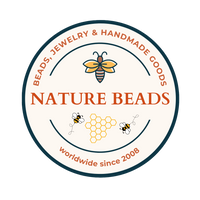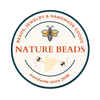
Picture from: https://www.amazonconservation.org/building-a-sustainable-forest-based-economy-for-the-amazon/
Acai Beads or Acai Berries was the very first product we offered and that's no surprise, I grew up playing with those berries, drinking the juice, popsicles and you name it. Everything that is made from and with Acai is that popular in the Amazon, my birthplace. I often have customers questioning me about the berries and how they turn into beads, etc. It's about time I put together a little info page for y'all.

Picture from: unknow
1. What's Acai Beads?
Acai (Euterpe oleracea) berries are a fruit of very tall and slender palm trees (up to 10 feet tall, maybe taller) that grow most in Central and South America, from Brazil to Guyana. The Acai palm tree has been used for centuries by the locals for house construction and the delicious hearts of palm and berries. Truly, I've always said that Acai is one of those mighty trees that you can use absolutely 100% of it. Bless them!
The Global demand for smoothie bowls and juice spiked the cultivation of the Acai palms to supply the demand.
The consumption of the Acai berries dates long before it got popular in the '90s. The indigenous people and locals have always used Acai juice as the super fruit you couldn't grow up without. It is a staple food known locally and often called the "Amazon superfood". Our ancestors believe that if you start drinking that strong and delicious juice early in age, you grow up to be super strong. Well, I highly agree with the locals, the number of antioxidants and vitamins that little berry offers is just amazing.

Picture from: unknow
2. What does the name Acai mean?

Picture from: oglobo.com
Acai was first used by the indigenous and so, the fruit was named "iwacai" which comes from the Tupi tribe meaning "the fruit that cries".
The legend says that the chief Itaki (e-ta-kee) ordered all newborns put to death during a starving time for the tribe. His own daughter Iaça (Ya-saa) gave birth to a child, a baby girl that was also sacrificed.

Picture from: oglobo.com
On the next full moon, after the sacrifices had taken place, Iaça woke up to the crying of a child. When she peered from her oca (tipi) she was startled to see it was her daughter standing next to a palm tree in the moonlight smiling at her. Iaça ran to her and clutched her in her arms. The next day Iaca’s body was found holding tight to the palm tree and gazing up at the berries with her dark eyes. The chief Itaki demanded that the berries be retrieved and made into a drink that was then named “Acai” after his late daughter Iaca. (Iaca is Acai spelled backward). There were no more sacrifices made and the tribe survived on this precious fruit.

Picture from: unknown
3. The Acai Berries
The Acai berries are small round little fruits that grow in big clusters. The Acai berries resemble blueberries in color and size, but they have very different tastes. The Acai Berries have very little pulp and the core of the fruit is a big seed that makes up to 6-80% of the fruit. The Acai palm bears fruit all year long and harvested during the Summer months.

Picture from: unknown
4. From seeds to beads?
Yes, as I said, 100% of the Acai palm tree is used for something. Once the Acai berries are processed and the pulp is extracted, the core of the berry, which is a seed that feels very much like a wooden bead is left out.

Picture from: Lilly (I took this picture, to use please credit author)
The raw seed is husked and hand drilled - yeah! Each seed is drilled by hand, it is a labor of love. Once all seeds are drilled, we husky them in very fast tumblers, then we soak them for some time so they can get cleaned. Once they're clean, they're dried and shipped from Amazon to us (NB studio in Florida).
When we received the raw seeds, we get busy dying and working our magic. We make each small batch with so much love and hope you will love them as much as we do.
We dye the beads with certified Italian dyes that are eco-friendly and azo-free, to ensure that your beads are non-toxic. We dye, polish and dry, and polish some more using wooden pegs and beeswax. We do not use any lacquer or varnish in our beads, they're perfect for all kinds of crafts and jewelry making.

Picture from: Lilly (I took this picture, to use please credit author)
Each seed is unique and no two are the same. Our "Natural Polished" Acai Beads are 100% natural and that's their color, that rich brown color. That is the first stage of the beads when they are being polished. As they get polished down and less bark is left on them, they will get lighter and lighter all the way to a light cream color.
They will also show a little black dot with a thicker speckle in the center of it and that is their birthmark. Each seed has one and each one is unique. The beads vary from 8-10mm round and if harvested during the rainy season, they will tend to be smaller.

Picture from: Lilly (I took this picture, to use please credit author)

Picture from: Lilly (I took this picture, to use please credit author)
5. How to care for Acai Beads?
Acai seeds feel very much like wooden beads. So, if you get them wet, dry with care. The best way to dry the beads is to place them over a little paper towel or cloth and let them stay there for a few hours. To give your jewelry a nice sheen, use a little bit of beeswax and spread throughout... I mean, very little! That stuff works great! You can use oils, just be aware that too much oil will make your beads look darker since wood tends to soak up oils. Note that color will change over time if you get them wet often.
Hope you enjoyed and if you wanna hear more stories, please contact us.
XoXo
Lilly Gonzaga




Leave a comment